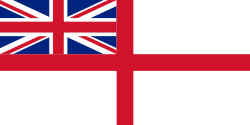
This page is intended to list the Naval Units that were stationed in BAOR after the end of WW2. Little is known of these units at this time, although JPW has carried out extensive research into which units were present, and at what dates(see above and below list of locations for notes from JPW).
Royal Navy personnel played an extremely important part in BAOR in the immediate aftermath of hostilities. Their duties were varied in that they were responsible for the clearance of mines and other ordnance from the coast, shipping lanes, and dock areas of Germany and for the gathering of Naval Intelligence in the Baltic and North Seas. Added to this was the hand over and disposal or destruction of German Navy vessels when, and sometimes where, they were surrendered to the Allied Forces.
The locations listed below are those that you may have seen on the Forum, plus others that may, possibly, have revealed themselves in the time after the post was made. Please note – there are two links for each entry; one for the Garrison/Shore Establishment area, and one for the Shore Establishment by name.
There was a significant Royal Navy presence in the then British Zone of Occupation in the period immediately following the German Surrender in May 1945. There follows a list of the Royal Navy Shore Establishments so far identified from open sources (the internet or public libraries); it is believed this list includes all the significant ports along the North Sea and Baltic coastline within the British Zone of Occupation with the exception of Husum (on the North Sea) and Kappeln (on the Baltic), but the latter may have been included in the tasks for the unit based in nearby Eckernforde. It should be noted that Bremen and Bremerhaven were in the American Zone.
These Shore Establishments might be regarded as the equivalent of Army Garrisons or Barrack names. They followed the theme of Princess or Royal names previously carried by 17th or 18th Century battleships. The majority of establishments had closed by the end of 1946, Wilhemshaven by the end of 1947. The Royal Navy presence in Cuxhaven, Hamburg and Kiel ended in the mid 1950s whilst HMS Royal Prince at Krefeld remained till the early 1960s.
Operation Eclipse was the British Plan for the situation immediately after the German Surrender and the creation of the British Zone of Occupation. The Naval Plans included the initial reception and surrender of all German naval vessels, the disarming and dispersal of all naval personnel, the identification and clearance of all maritime minefields and most importantly the destruction of any facility that might enable Germany to challenge the supremacy of the Royal Navy in European waters.
Manpower for the individual locations was provided, in accordance with Royal Navy practice, in the form of Naval Parties numbered in the Series 1700-1899 and varied in size from 145 Officers and 693 Ratings (Hamburg) to 5 Officers and 32 Ratings (Sylt) reflecting the size and complexity of the role and tasks. This is the subject of a separate study.
JPW
Any information that can be provided on these, and any other Naval Units in Germany will be very welcome.
Berlin – HMS Princess Irene
Brunsbuttel – HMS Princess Louise
Cuxhaven – HMS Augusta, HMS Royal Albert, HMS Royal Charlotte, Control Commission Germany, Minesweeping Unit
Eckernförde – HMS Princess Caroline
Emden – HMS Royal Prince
Flensburg – Princess Alexandra
Hamburg – HMS Royal Albert, HMS Royal Edgar, RN/RM Elbe Flotilla/RN/RM Elbe Squadron, T Company Royal Marine Engineers
Kiel – HMS Royal Charlotte, HMS Royal Harold, 117 Infantry Brigade Royal Marines, British Baltic Fishery Protection Service
Krefeld – HMS Royal Prince, Rhine Flotilla/Rhine Squadron, RM Demolition Unit/Special Boat Section Royal Marines
Lübeck – HMS Royal Caroline, 1 Commando Brigade Royal Marines
Minden – HMS Royal Albert, HMS Royal Henry, 4 Commando Brigade RM
Plön – HMS Royal Alfred
Tönning – HMS Royal Adelaide
Travemünde – HMS Royal Caroline
Wilhelmshaven – HMS Royal Katherine, HMS Royal Rupert
HELP WANTED
It is known that the principal Naval HQ IN Germany at the end of World War2 was Headquarters Allied Command Naval Expeditionary Force Europe (ANCXF) in May 1945 but was subsequently renamed to reflect its British role but this again altered over the years. Similarly the exact location is believed to have changed. Minden, Hamburg, Kiel and Köln (linked to JHQ Rheindahlen) are known to be places but exact dates are unclear.
The exact title of the senior Royal Navy Appointment in Germany is unclear. In Summer 1945 it is understood that the title was Commander Allied Naval Expeditionary Force, subsequently both the terms “Commander Royal Navy (Germany)” and ”Flag Officer Germany” may have been used.
JPW
